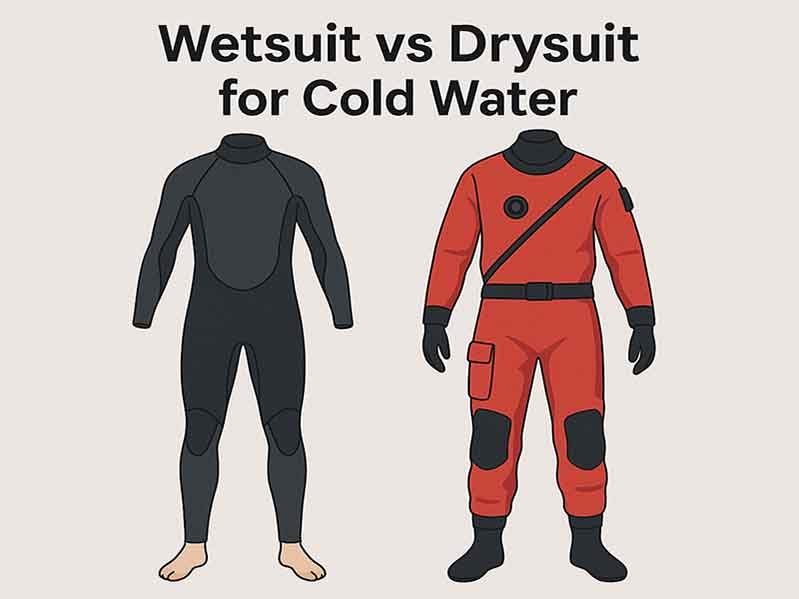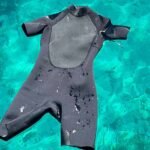When you think about plunging into icy waters, you might imagine an experienced diver effortlessly slicing through frosty waves. But behind that seemingly simple gear lies years of innovation and choices that can mean the difference between shivering uncontrollably and staying warm enough to enjoy an extended underwater adventure. Choosing the right suit is crucial because it directly affects both comfort and safety.
Wetsuits work by allowing a thin layer of water to seep in and warm up against your skin, while drysuits keep you completely insulated from water by using seals and undergarments. Each option has its own advantages depending on temperature, activity level, and personal preference. Understanding how each suit functions—and when one makes more sense than the other—can be surprisingly complex.
Imagine a passionate cold-water surfer catching the early morning waves off the Pacific Northwest coast. On frigid winter mornings, a wetsuit might keep them warm enough to ride wave after wave. Yet, if they wanted to venture scuba diving in Alaskan waters where temperatures drop even lower, they would likely switch to a drysuit for better insulation and protection. The right suit doesn’t just keep you warm—it lets you focus on the experience without worrying about biting cold. Ready to dive in and learn which gear is best for your next chilly-water adventure? Let’s explore everything from materials to maintenance so that you can make an informed choice.
What Are Wetsuits and How Do They Keep You Warm in Cold Water?
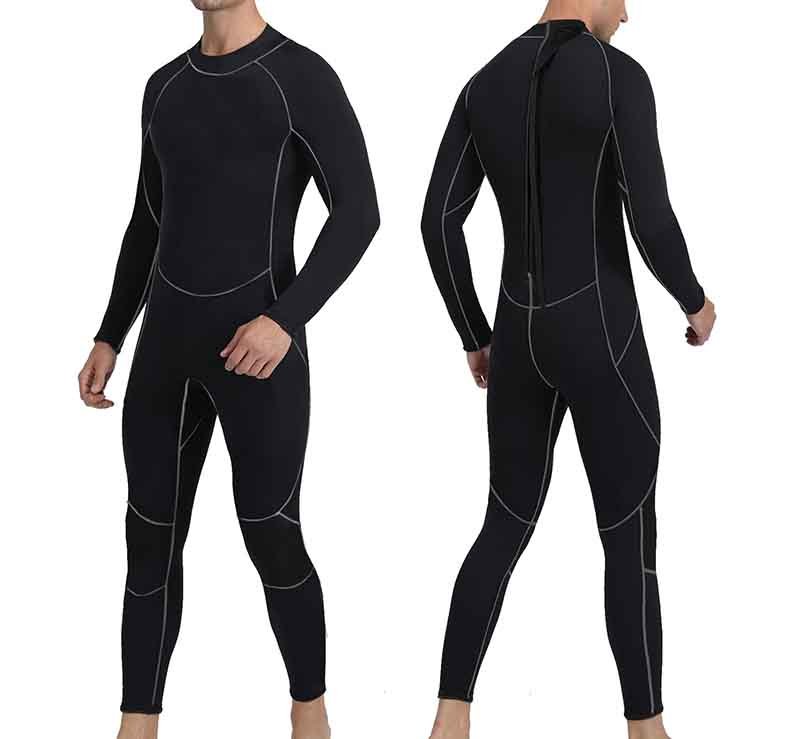
Wetsuits are made of neoprene foam that traps a thin layer of water between your skin and the suit. As you move, body heat warms this trapped water, creating an insulating barrier against cold temperatures. By fitting snugly, wetsuits minimize water exchange, helping keep you warm even when the water is cool.
How Wetsuit Design Relies on Neoprene Foam
- Neoprene Structure and Insulation
- Neoprene is a synthetic rubber filled with tiny nitrogen gas bubbles, which reduce heat conduction.
- Thickness typically ranges between 2 mm for warm water to 7 mm or more for colder temperatures.
- Fit and Seal
- A proper fit is crucial: Too loose, and cold water flushes in; too tight, and mobility is restricted.
- Seals at wrists, ankles, and neck reduce water exchange, though some water still seeps in and warms up.
- Types of Wetsuit Cuts
- Full suits cover arms and legs, ideal for cold water under 60°F.
- Spring suits (short arms and legs) suit slightly warmer conditions around 65–70°F.
- Two-piece suits and hooded vests offer flexibility for layering based on water temperature.
Unpacking Insulation and Heat Retention
Trapped Water Layer
- When you enter the water, a small amount of water seeps in and warms to body temperature.
- This warmed layer acts as a buffer, reducing heat loss to surrounding cold water.
- If your suit is too loose, cold water continuously flushes the interior, causing rapid heat loss.
Neoprene Thickness Choices
- 2–3 mm Wetsuits: Best for water above 65°F where moderate insulation is enough.
- 4–5 mm Wetsuits: Commonly used in water temperatures between 50°F and 65°F.
- 6–7 mm Wetsuits: Designed for extremely cold water under 50°F, often paired with gloves and hoods to cover exposed skin.
Seams and Gluing
- Seams may be flatlocked (sewn flat) or glued and blind stitched to reduce water penetration.
- High-end suits often use liquid tape or liquid seams to seal any needle holes, preventing water entry.
Examining Wetsuit Performance: Real-Life Scenarios
- Surfing in Pacific Northwest (Water ~50°F)
- A 5/4/3 mm wetsuit (5 mm torso, 4 mm arms, 3 mm legs) keeps surfers comfortable for hours in icy waves.
- Integrated hoods and wrist seals limit water flow, allowing extended sessions without teeth-chattering.
- Freediving in Temperate Waters (Water ~60°F)
- A 3 mm full wetsuit strikes a balance between insulation and flexibility, facilitating easier movement during dynamic breath-hold dives.
- Stretch panels at shoulders and knees enhance mobility for fin kicks and reaching out to grab underwater ledges.
- Triathlon Ice Swims (Water ~55°F)
- Ultra-thin 2 mm wetsuits are used because mobility and hydrodynamics outweigh maximum insulation.
- Water exchange is minimized by a tight fit, and athletes rely on rapid swim pace to keep warm until exiting the water.
Addressing Common Misconceptions
- Myth: Wetsuits Are Only for Warm Water
- In fact, thicker wetsuits specialize in cold-water use. Some models even add fleece linings for extra warmth.
- Misunderstanding Fit and Sizing
- Wetsuits often run small, and different brands fit differently. Always try on before buying or request multiple size samples for OEM testing.
- Assuming All Neoprene Offers the Same Insulation
- Higher-density neoprene can be both thinner and warmer, reducing bulk without compromising insulation. Brands like Yamamoto specialize in premium neoprene.
What Are Drysuits and How Do They Maintain Insulation in Frigid Conditions?
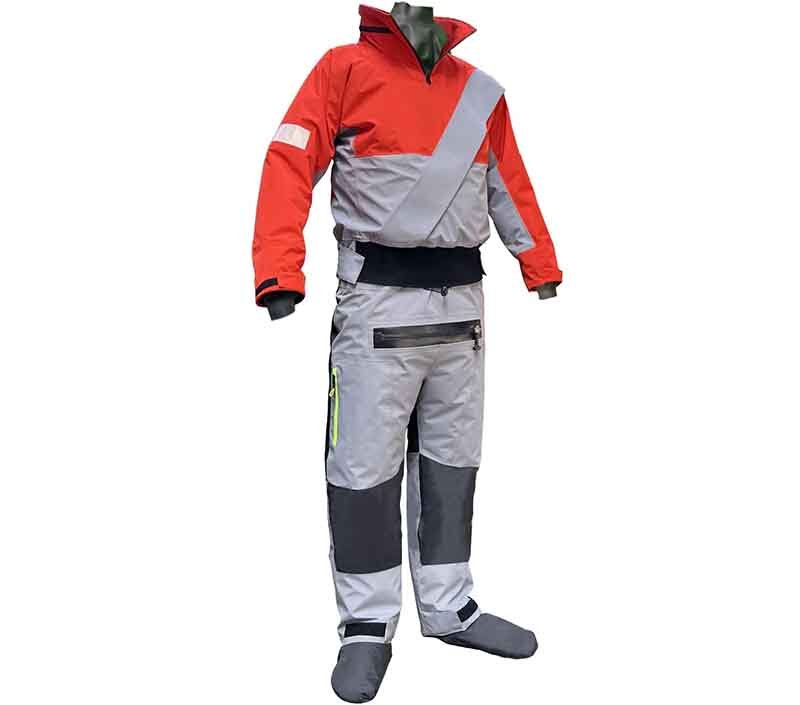
Drysuits create a watertight barrier that prevents water from contacting your body; insulation comes from layered undergarments worn inside. By keeping water out completely, drysuits allow you to stay dry and add thermal layers as needed, making them ideal for extremely cold water below 50°F.
The Structure and Function of a Drysuit
- Materials and Seals
- Typically made of trilaminate nylon, neoprene, or vulcanized rubber.
- Seams are welded or taped rather than sewn to ensure no water entry.
- Neck and wrist seals use latex or neoprene to create waterproof barriers.
- Inflation and Pressure Management
- A manual inflation valve on the chest allows small amounts of air to enter, preventing suit squeeze at depth.
- Exhaust valves on the upper arm or shoulder release excess air when surfing or diving deeper.
- Undergarment Layers
- Insulating undergarments—usually fleece, wool, or synthetic thermal fabrics—trap body heat inside.
- Layering systems can be adjusted: a thin base layer for moderate cold or multiple fleece layers for near freezing.
How Drysuit Insulation Differs from Wetsuit Insulation
No Direct Water Contact
- Because the suit remains dry, your body heat does not warm a water layer; instead, it warms air trapped between undergarments and suit.
- Effective in frigid temperatures where a wetsuit’s trapped water would quickly steal your heat.
Adjustable Insulation Levels
- Change the number or thickness of undergarment layers based on temperature and activity: hiking on ice floes before diving requires smaller layers than sitting in a driftboat for an hour.
- Some divers pack multiple undergarment kits to switch mid‐expedition, ensuring comfort as conditions change.
Buoyancy Considerations
- Air in the suit adds buoyancy, requiring careful weight adjustments in diving.
- Proper buoyancy control minimizes risk of uncontrolled ascents or descents that might cause decompression issues.
Drysuit Applications: Why They Excel in Cold Conditions
- Scuba Diving Below 50°F
- In Alaska, divers use trilaminate drysuits with heavy fleece undergarments to stay warm while inspecting oil rigs or researching marine life.
- Inflator controls allow consistent buoyancy during long dives, even as undergarments compress at depth.
- Kayaking in Polar Regions (Water ~32°F)
- Sea kayakers in Greenland don drysuits with a fleece mid‐layer, preventing immediate hypothermia if capsizing in frigid fjords.
- Wrist and neck seals keep water out completely, so gear remains dry even after repeated roll attempts.
- Industrial and Rescue Operations
- Emergency response teams wear neoprene drysuits when dealing with icy water rescues. Dry suits protect from prolonged exposure and allow mobility without risking cold‐water immersion effects like cold shock or loss of dexterity.
Challenges and Considerations with Drysuits
- Learning Curve and Fit
- Getting into a drysuit often requires assistance; latex seals can tear if not handled gently.
- Proper fit is crucial: too tight and mobility is restricted; too loose and undergarments bunch, creating cold spots.
- Cost and Maintenance
- Drysuits cost two to three times more than mid‐range wetsuits due to specialized materials and valves.
- Annual maintenance—checking seals, valves, and suit integrity—adds to the long‐term cost.
- Risk of Suit Squeeze or Overexpansion
- Incorrect air management can cause suit squeeze (painful pressure on chest) or rapid ascents (excess buoyancy), requiring diver training and experience.
Which Is More Effective for Cold-Water Environments?
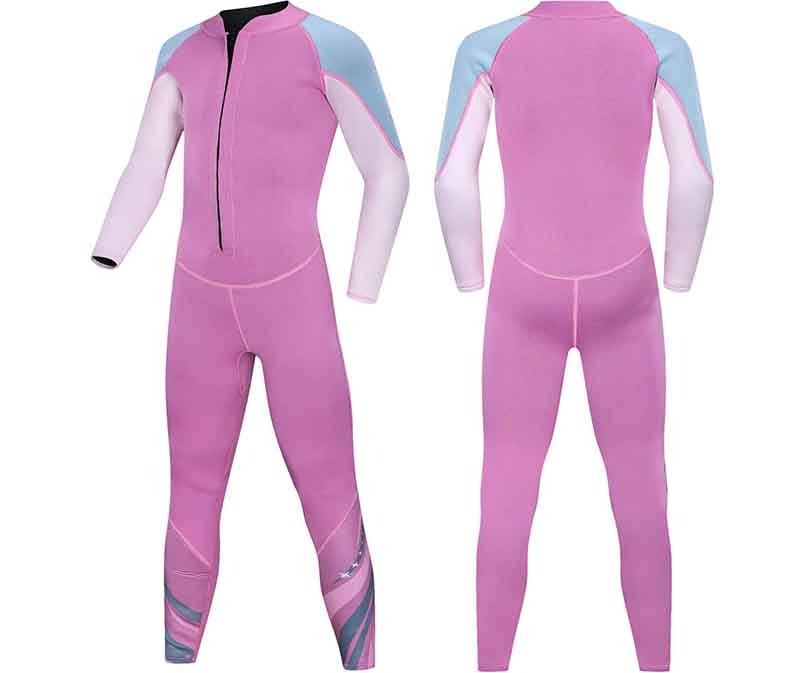
Effectiveness depends on water temperature, activity level, and personal comfort; wetsuits excel in water above 50°F with active movement, while drysuits outperform in frigid water below 50°F or low‐activity situations by keeping you completely dry.
Is a Wetsuit or Drysuit Better for Cold Water?
- Temperature Threshold
- Wetsuits are generally recommended for water temperatures between 50°F and 65°F.
- Drysuits are advisable for water temperatures below 50°F or extended exposure in any cold water.
- Activity Level
- Active sports like surfing or triathlon swimming generate body heat, making a thick wetsuit sufficient in cooler water.
- Low‐activity pursuits—like paddleboarding or photography—benefit from a drysuit since you generate less warmth and need more insulation.
Factors to Weigh When Choosing Between Wetsuit and Drysuit
Water Temperature and Duration
- Short Exposure vs. Long Exposure
- If you plan a quick dive or surf session, a 5 mm wetsuit may suffice in 50°F water for 20–30 minutes.
- For hour‐long dives or fishing trips, a drysuit with a fleece undergarment keeps you warm throughout, reducing risk of hypothermia.
- Seasonal Variations
- Late spring or early fall, when water might hover around 55–60°F, wetsuits can still work if layered or paired with a hood.
- Deep winter, with water dipping into 40s°F, drysuits are virtually mandatory for extended immersion.
Comfort and Mobility
- Flexibility
- Wetsuits offer better stretch and fit for dynamic movement. A surfer benefits from unimpeded paddling and pop‐ups on their board.
- Drysuits feel baggier and restrict some range of motion; however, modern “undergarmentless” drysuits use stretch panels to improve fit and movement.
- Thermal Comfort
- A wet suit can feel clammy when you first enter, requiring time for that thin water layer to warm.
- A drysuit feels immediately dry, but you might feel colder until you warm up the trapped air with light movement.
Safety Considerations
- Cold Water Shock and Hypothermia
- Sudden immersion in cold water can cause rapid breathing and heart rate spike; wetsuits offer limited protection against cold shock if water is below 50°F.
- Drysuits provide a more reliable barrier, but you must be trained in inflator and exhaust valve use to prevent squeeze and overexpansion.
- Buoyancy and Cargo
- Wetsuits add about 1–2 kg of buoyancy depending on thickness. This helps open‐water swimmers but may require slight weight adjustments for divers.
- Drysuits can add 3–5 kg of buoyancy due to trapped air. Proper weight belt calibration is critical to prevent uncontrolled ascents.
How Do Neoprene Materials and Construction Methods Impact Performance?

Neoprene quality, panel design, seam type, and lining choices directly influence warmth, flexibility, and durability in both wetsuits and drysuits. High‐end neoprene with closed‐cell foam and strategic tape reinforcements can outperform basic versions, but at a higher price point.
Material Innovations That Make a Difference
Neoprene Foam Density and Stretch
- Standard Neoprene vs. Yamamoto Neoprene
- Standard neoprene has a closed‐cell foam structure.
- Yamamoto neoprene, used in premium suits, contains denser nitrogen bubbles, offering up to 20 percent more warmth at the same thickness.
- S‐Flex and Super Stretch Neoprene
- Enhanced stretch neoprene panels at shoulders and knees allow for greater range of motion.
- These panels maintain insulation while reducing bulk, making them ideal for technical diving or competitive surfing.
Laminated Linings and Thermal Brushed Finishes
- Nylon Lining vs. Thermal Fleece Lining
- Nylon‐lined interior offers durability and easy donning.
- Thermal fleece lining retains more body heat, especially beneficial in water below 55°F.
- Ultraspan and Quick‐Dry Liners
- Some suits use quick‐dry interior panels that wick moisture away, reducing chill once out of the water.
- These liners can speed up suit removal after long sessions, enhancing comfort.
Seam Construction Techniques
- Flatlock Stitching
- Flatlocked seams are sewn with overlapping panels and visible double threads.
- Comfortable and flexible but allow some water seepage—best for water above 65°F.
- Glued and Blind Stitched (GBS)
- Panels are glued together then stitched without penetrating through to inner layers.
- Reduces water entry, offering more warmth in cooler conditions.
- Liquid Seamed or Ultrasonic Welded
- High‐end drysuits often use welded seams or liquid tape to seal stitch holes completely.
- Guarantees zero water entry, critical for drysuite performance.
Construction Details That Affect Suit Life Span
Panel Layout and Tapered Design
- Anatomical Panel Layout
- Suits cut to follow body contours minimize bunching.
- Strategically placed stretch panels improve flexibility in key areas like shoulders, knees, and waist.
- Tapered Thighs and Calves in Drysuits
- Custom tapering in neoprene drysuits reduces excess air pockets that can cause buoyancy shifts at depth.
- Reduces material bulk, enhancing streamlining for divers.
Reinforcements and Wear Zones
- External Knee and Elbow Pads
- Reinforced knee and elbow patches made of kevlar or Cordura extend suit life in high‐abrasion spots.
- Particularly important for divers who kneel on rocky floors or surfers who spend hours paddling on boards.
- Seat and Crotch Reinforcements
- Drysuit retailers often add a double layer of neoprene on seat and crotch to protect from zipper rub and harness wear.
- Extends durability when carrying heavy gear or working on boat decks.
What Are the Pros and Cons of Wetsuits vs Drysuits for Different Cold-Water Activities?
Wetsuits excel for active sports in moderately cold water, offering flexibility and lower cost, while drysuits provide superior protection for stationary tasks or extreme cold but come at a higher price and require more training.
Wetsuits: Advantages and Drawbacks for Various Activities
1. Surfing and Bodyboarding
- Advantages
- High mobility appeals to dynamic paddling and quick pop‐ups onto the board.
- Thicker foam panels at chest and back reduce cold shock when duck‐diving under waves.
- Generally more affordable and easier to don without assistance.
- Drawbacks
- Cold water seeps in around seals, causing initial chill before the water warms to body temperature.
- Trapped water can cause drag during longer sessions, leading to fatigue.
- Limited insulation in marginally cold conditions; may need a hood, gloves, and boots to stay comfortable.
2. Scuba Diving and Snorkeling
- Advantages
- Wetsuits are common for tropical and temperate diving down to 60°F.
- Full suits with hood and booties can extend use into colder water if dive time is short.
- Lighter weight gear enhances fin kicks and reduces buoyancy adjustments.
- Drawbacks
- In water below 50°F, wetsuits offer insufficient insulation; divers risk cold‐induced narcosis or reduced dexterity.
- Requires rigorous layering or switching to a drysuit for prolonged cold dives.
3. Kayaking, Paddleboarding, and Fishing
- Advantages
- Wetsuit flexibility allows for better paddling technique and movement.
- Economical for occasional falls into cold water, preventing full immersion hypothermia for short periods.
- Drawbacks
- If you spend extended time sitting still on a kayak in 50°F water, heat loss is rapid.
- Waterlogged neoprene can chafe, causing discomfort during longer outings.
Drysuits: Advantages and Drawbacks for Various Activities
1. Cold-Water Scuba Diving and Technical Diving
- Advantages
- Keeps divers completely dry, allowing extended bottom time and reducing risk of hypothermia.
- Insulating undergarments can be customized: light fleece for 55°F water, heavy wool for 35°F water.
- Trilaminate suits are abrasion resistant, ideal for exploring wrecks or caves where contact with surfaces is common.
- Drawbacks
- Learning curve: divers must master valve management to prevent squeeze or uncontrolled ascents.
- Costs can be two times higher than mid‐range wetsuits; annual servicing and valve maintenance add to expenses.
2. Cold-Water Kayaking, Canoeing, and Stand-Up Paddleboarding
- Advantages
- Drysuits protect paddlers from constant splashes and wind chill, staying dry for hours in 45°F water.
- Flexible neoprene socks integrated into the suit eliminate water ingress, keeping feet dry.
- Layering undergarments allows paddlers to stay warm whether hunching over a kayak or standing on a board.
- Drawbacks
- Bulkier and less breathable than wetsuits; may feel overly warm during intense paddling in milder conditions.
- Putting on a drysuit is more involved; wrist seals require careful handling to avoid tears.
3. Cold-Water Rescue and Industrial Applications
- Advantages
- Rescue teams can perform prolonged operations in 40°F water without succumbing to cold.
- Oil and gas platform workers use drysuits to stay safe when working on vessel decks or in splash zones.
- Drawbacks
- Suit failures (torn seals or zipper issues) can lead to unexpected water ingress, posing safety risks.
- Initial purchase and maintenance represent a significant investment for organizations.
How to Compare OEM and ODM Neoprene Wetsuit and Drysuit Manufacturers?
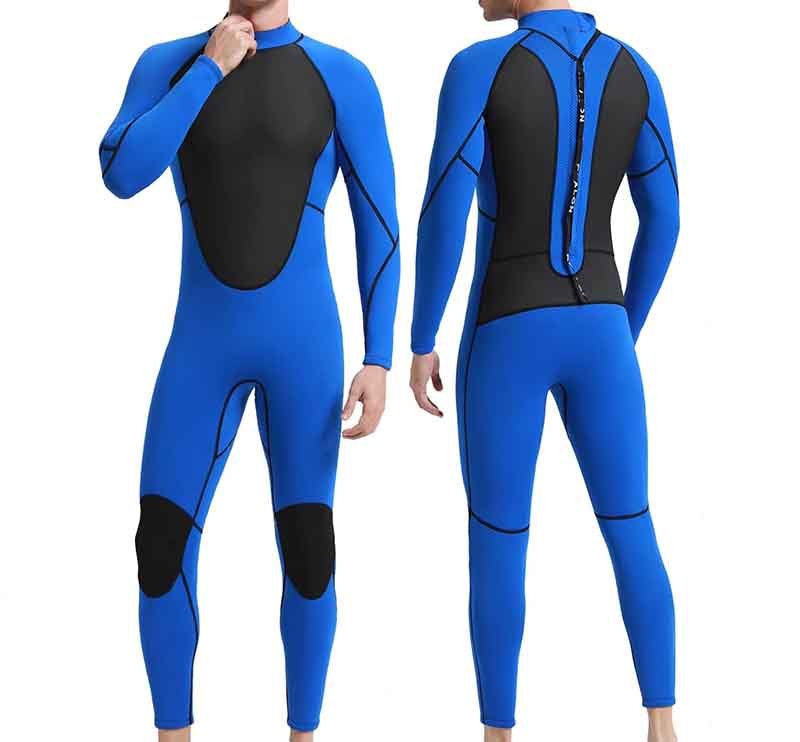
When evaluating OEM and ODM neoprene manufacturers, B2B buyers should examine quality certifications, sample offerings, minimum order quantities, customization capabilities, pricing transparency, and after‐sales support.
What to Look for in an OEM/ODM Partner
1. Experience and Reputation
- Years in Business
- Companies with over a decade of experience—like Szoneier, with 18 years in neoprene research and production—tend to have more refined processes and proven track records.
- Client Portfolios and Testimonials
- Ask for references from past clients to verify reliability, product quality, and on‐time delivery performance.
2. Product Quality and Certifications
- Neoprene Standards
- Look for CR (chloroprene rubber) neoprene with consistent density and low ammonia odor.
- Ask if the factory uses limestone‐based neoprene, which is more eco friendly than traditional oil‐based neoprene.
- Certifications
- ISO 9001: Quality management systems guarantee consistent production quality.
- Oeko‐Tex Standard 100: Ensures that no harmful substances are present in fabrics or chemicals.
- REACH Compliance: Indicates that the manufacturer adheres to EU regulations on chemical safety.
3. Customization and Design Support
- Pattern Making and Prototyping
- Does the manufacturer offer free design services and sample prototyping?
- Ask how many rounds of sample iterations are included in the MOQ and whether costs are refundable against bulk orders.
- Logo Printing and Branding
- Screen printing, heat transfer labels, or embossing: Verify print quality and durability.
- Confirm color matching processes: Pantone referencing or digital color meters ensure consistency across batches.
4. Minimum Order Quantity (MOQ) and Pricing Structure
- MOQ Levels
- Lower MOQs—such as 50 units per style—allow small brands to test new designs without hefty inventory.
- Tiered Pricing
- Manufacturers often offer tiered pricing: e.g., $20 per wetsuit for 100–499 units, $18 for 500–999 units, $16 for 1,000+ units.
- Confirm whether pricing includes custom packaging or if that is billed separately.
5. Production Capacity and Lead Times
- Factory Scale and Monthly Output
- A factory capable of producing 30,000 suits per month can handle large orders without significant delay.
- Ask for current production schedules during peak seasons, such as summer, when demand spikes.
- Lead Times
- Standard lead times range from 30 to 45 days after sample approval.
- Rush production—is a surcharge possible for 15‐day turnaround?
6. Quality Control and After‐Sales Services
- Inspection Protocols
- Check if the manufacturer performs 100 percent visual inspection and random tensile tests before shipment.
- Warranty and Defect Policies
- Understand defect return policies: Are returns accepted within 30 days of delivery for defective items?
- Does the manufacturer offer repair or replacement for shipping damage during transit?
What Maintenance and Care Practices Ensure Longevity for Wetsuits and Drysuits?
Proper cleaning, drying, storage, and minor repairs can extend suit lifespan from 1–2 years to 4–5 years, saving costs over time.
Wetsuit Care: Keep Your Suit Flexible and Odor Free
1. Cleaning After Each Use
- Rinse with Freshwater
- Saltwater, chlorine, sunblock, and sweat can degrade neoprene. Rinse thoroughly with cool freshwater within minutes of exiting the water.
- Use a Mild Detergent or Wetsuit Shampoo
- Dilute a neoprene‐safe soap in a bucket of water. Gently wash the suit inside and out, focusing on high‐odor zones like armpits and groin.
- Avoid Harsh Chemicals
- Bleach, detergents with solvents, or fabric softeners can weaken neoprene’s foam cells. Stick to pH‐neutral cleansers.
2. Drying Techniques
- Hang Inside Out Initially
- Turn your wetsuit inside out and hang over a thick plastic hanger in a shaded, ventilated space. This ensures the interior dries first, reducing mold risk.
- Flip It After Interior Dries
- Once the inside is dry, flip the suit back to its correct orientation so the exterior can dry. Avoid direct sunlight to prevent UV damage.
- Avoid Tumble Dryers or Heat Sources
- Excessive heat can cause neoprene to shrink or peel.
3. Storage Best Practices
- Lay Flat or Use a Wide‐Bar Hanger
- Thin wire hangers or folding wetsuits can create creases that weaken neoprene over time.
- Keep Away from Heat and Light
- Store in a cool, dark closet or in a breathable suit bag. Anywhere with consistent temperature avoids thermal cycling that degrades materials.
- Prevent Unwanted Odors
- Use a small silica gel pack near your wetsuit to absorb moisture. If storing for months, periodically air out the suit.
4. Minor Repairs and Patch Kits
- Use Neoprene Cement or Repair Tape
- Small tears can be repaired with neoprene cement or self‐adhesive repair tape. Clean the area, apply adhesive, then press firmly for 30 seconds.
- Replace Worn Seals and Zippers
- Over time, ankle and wrist seals stretch or crack. Replace with neoprene or latex seals available in repair kits.
- Check zipper teeth for bends; align with a pair of pliers to ensure smooth operation.
Drysuit Care: Protecting Seals, Valves, and Fabric Integrity
1. Post‐Use Cleaning
- Rinse Inside and Out
- Freshwater flush helps remove salt, sand, or contaminants that can degrade seals and fabric coatings.
- Neutral Soap for Fabrics
- Use pH‐neutral soaps to clean the trilaminate or neoprene exterior. Gently scrub undergarment residue from the suit.
- Pay Special Attention to Seals and Valves
- Wipe seals with a silicone‐based seal conditioner to prevent cracking.
- Flush valves with fresh water to keep them functioning smoothly.
2. Drying and Storage
- Hang Suited Upside Down
- Use a specialized drysuit hanger that supports shoulders and prevents water pooling in ankles.
- Ensure seals are propped open slightly so any trapped moisture can evaporate.
- Avoid Folding
- Folding can cause creases that eventually lead to leaks. Always store hung or rolled loosely with a protective sheet.
- Check Seals for Degradation
- Latex seals can lose elasticity within 1–2 years; neoprene seals can last 3–5 years. Regularly inspect and replace if cracking or discoloration appears.
3. Valve Maintenance
- Inspect and Clean Valves Monthly
- Remove inflator and exhaust valves, rinse with fresh water, then dry completely before reassembly.
- Check O‐rings for cracks and lubricate with manufacturer‐approved lubricant.
- Leak Testing
- Inflate the suit, submerge the sealed cuffs in a small tub of water, and watch for bubbles. Bubble trails indicate leaks that need repair before next dive.
4. Professional Servicing and Annual Checks
- Manufacturer Maintenance Programs
- Many drysuit makers offer an annual service package: seal replacement, valve rebuild, and pressure test for a flat fee (e.g., $75–$100).
- DIY Repair Kits
- Keep a patch kit handy for emergency on‐site repairs. Kits include adhesive patches, seal conditioner, and spare O‐rings.
- Record Keeping
- Maintain a log of repairs, seal replacements, and valve services. This helps plan future maintenance and prevents unexpected failures in the field.
Conclusion
Choosing between a wetsuit and a drysuit ultimately comes down to your water temperature, activity level, budget, and comfort preferences. Wetsuits shine for active sports in moderately cold water by allowing mobility and breathability, while drysuits offer total insulation for stationary or extreme cold-water tasks. Both require thoughtful consideration of material quality, construction, and aftercare to ensure your investment lasts.
If you’re ready to elevate your cold-water gear—or start a private-label line of wetsuits, drysuits, or other neoprene products—contact Szoneier today. With over 18 years of experience in neoprene research, development, and manufacturing, we offer free design services, low minimum order quantities, fast sampling, and 100 percent quality assurance. Let us help you customize products that meet your exact specifications, whether you need surf-ready wetsuits, professional dive drysuits, or promotional neoprene accessories. Reach out for a personalized quote and discover how Szoneier can bring your vision to life!

